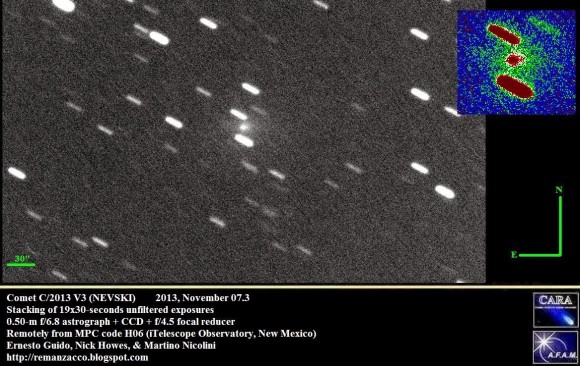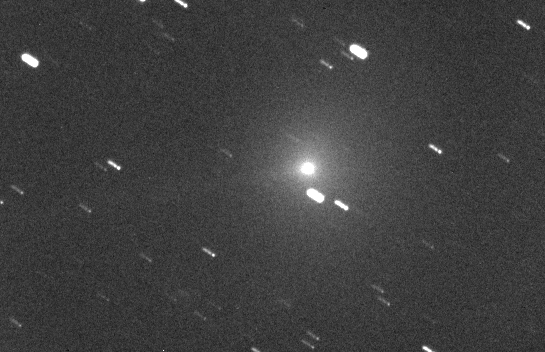

| Visitors Now: | |
| Total Visits: | |
| Total Stories: |
Meet The Newest Comet / Comet C/2013 V3 Nevski Now Visible With Binoculars
Meet The Newest Comet / Comet C/2013 V3 Nevski Now Visible With Binoculars

Is 2013 truly the “Year of the Comet?” Perhaps “Comets” might be a better term, as no less than five comets brighter than +10th magnitude grace the pre-dawn sky for northern hemisphere observers.
Comet C/2013 V3 Nevski has just brightened up 6 magnitudes — just over a 250-fold increase in brightness — and now sits at around magnitude +8.8. Comet Nevski was just recently discovered by Vitali Nevski using a 0.4 metre reflecting telescope 12 days ago on November 8th. If that name sounds familiar, it’s because Nevski discovered the comet from the Kislovodsk observatory located near Kislovodsk, Russia which is part of the International Scientific Optical Network survey which located comet ISON last year. In fact, there was some brief controversy early on in its discovery that Comet C/2012 S1 ISON should have had the moniker Comet Nevski-Novichonok.

Comet Nevski captured on November 14th by Gianluca Masi. (Credit: The Virtual Telescope 2.0 Project).
At the time of discovery, Comet Nevski appeared to be nothing special: shining at magnitude +15.1, it was well below our +10 magnitude limit for consideration as “interesting,” and was projected to linger there for the duration of its passage through the inner solar system. About a dozen odd such comet discoveries crop up per year, most of which give astronomers a brief pause as the orbit and size of the comet become better known, only to discern that they’re most likely to be nothing extraordinary.
Such was to be the case with Comet Nevski, until it suddenly flared up this past weekend.
Comet Nevski is Halley-type comet, with a 27.5 year orbit.
So, looking at the “Comet Scorecard,” we currently have:
Comet C/2012 X1 LINEAR: Still undergoing a moderate outburst at magnitude +8.2, very low to the north east for northern hemisphere observers at dawn in the constellation Boötes.
Comet 2P/Encke: Reaches perihelion tomorrow at 0.33 AU’s from the Sun, shining at magnitude +7.7 near Mercury in the dawn sky but is now mostly lost in the Sun’s glare.
Comet C/2013 R1 Lovejoy: is currently well placed in the constellation Ursa Major crossing into Canes Venatici in the hours before dawn. Currently shining at magnitude +5.4, Comet R1 Lovejoy is visible to the unaided eye from a dark sky site. We caught sight of the comet last week with binoculars, looking like an unresolved globular cluster as it passed through the constellations of Leo and Leo Minor.
And of course, Comet C/2012 S1 ISON: As of this writing, ISON is performing up to expectations as it approaches Mercury low in the dawn shining at just above +4th magnitude. We’ve seen some stunning pictures as of late as ISON unfurls its tail, and now the eyes of the astronomical community will turn towards the main act: perihelion on November 28th. Will it fizzle or dazzle? More to come next week!
The recent outbursts of Comets X1 LINEAR and V3 Nevski are reminiscent of the major outburst of Comet Holmes back in 2007. Of course, the inevitable attempts to link these outbursts to the current sputtering solar max will ensue, but to our knowledge, no conclusive correlations exist. Remember, the outburst from Comet Holmes occurred as we were approaching what was to become a profound solar minimum.
You can also visit me at:
.png)
Be AWARE and be PREPARED, FEAR is not an option. Be safe everyone…





“When it rains, it pours”…
We live in amazing times…
Thank you for sharing!
z.